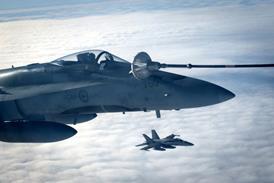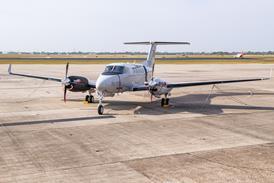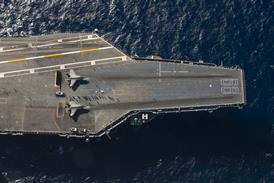By Rob Coppinger in London
Trials to start in second quarter of 2011, while contract could be placed in 2008
Flight tests of the Crew Launch Vehicle’s (CLV) upper stage will begin in the second quarter of 2011, according to the development timetable presented at NASA’s industry day on 19 April.
 The CLV upper stage will push the four-/six-person Crew Exploration Vehicle (CEV) from a suborbital trajectory into low- Earth orbit (LEO). The CEV/CLV first and upper stage stack will be 94m (309ft) tall, have a gross take- off weight of 909,000kg (2 million pounds) and have a 25t-to-LEO payload capacity. The flight tests will continue through 2011 and 2012.
The CLV upper stage will push the four-/six-person Crew Exploration Vehicle (CEV) from a suborbital trajectory into low- Earth orbit (LEO). The CEV/CLV first and upper stage stack will be 94m (309ft) tall, have a gross take- off weight of 909,000kg (2 million pounds) and have a 25t-to-LEO payload capacity. The flight tests will continue through 2011 and 2012.
During the CLV’s 10min flight the first stage will separate after 131s at 195,600ft and the upper stage engine fire at 133s and burn for 463s. During this time the CEV capsule’s launch abort system is ejected. The 5.5m-diameter aluminum-lithium upper stage will be powered by a Apollo-derivative liquid-oxygen/liquid-hydrogen J-2X engine and will contain the avionics and reaction control system, providing the roll control needed for the first stage’s flight.
A request for proposals for the upper stage is planned for the fourth quarter of 2007.
According to the industry day presentation by CLV upper-stage element manager Danny Davis, the contract would be placed by the third quarter of 2008.
The schedule also shows that manufacturing process development will begin this year and avionics development tests should start in the second quarter of 2008. At the same time the battleship stage will organise engine hot fire and pressurisation system performance tests.
From the end of 2008 the vibration test article work starts, which sees dynamic testing at NASA Marshall Spaceflight Center in Alabama. The qualification hardware fabrication and testing is in the first quarter of 2009 and flight unit manufacturing starts in 2010.
Although the CLV and NASA’s proposed 125t-to-LEO Cargo Launch Vehicle are described as Shuttle-derived, NASA designates the CLV upper stage as a clean-sheet design.
The systems requirement review for the CLV’s first stage will be in September, at the same time as the CEV. ATK has been awarded a $28.6 million contract to continue developing the first stage, which is a recoverable five-segment solid rocket booster that uses polybutadiene acrylonitride propellant.
Graphic © Flight International
Source: Flight International























